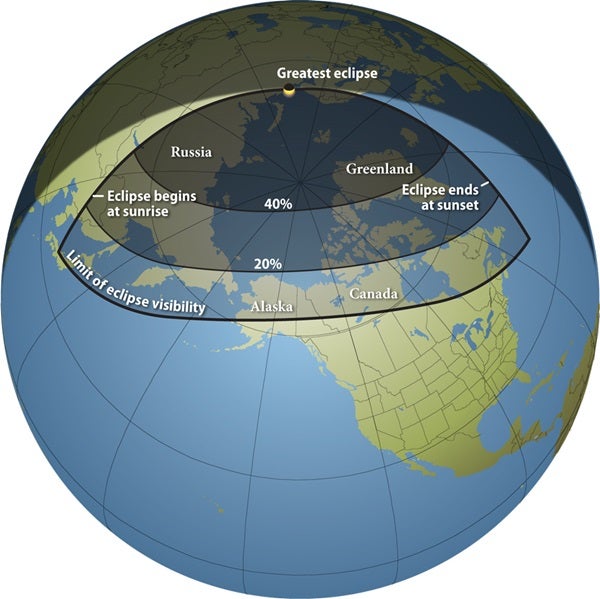The Sun falls under attack in early June when the Moon passes in front of it to create a partial solar eclipse. Although the alignment isn’t perfect enough to form a full eclipse, watching the Moon take a bite out of the Sun will still be a dramatic event for observers in northern climes.
On June 1, people in northern North America, northern Europe, and northeastern Asia can witness the partial eclipse. Those in the northern two-thirds of Alaska and much of northern Canada will see the Moon block up to 20 percent of the Sun’s disk, and the maximum eclipse happens along Russia’s north coast, where 60 percent of the Sun will disappear. “Solar eclipses, even partial ones, are always amazing shows,” sais Michael E. Bakich, a senior editor of Astronomy magazine. “This one may be a little out of the way, but you won’t be sorry if you make the trip.”
Just as with any solar eclipse, viewers should take care never to look directly at the Sun with the naked eye. Sunlight can damage the eye’s retina quickly and painlessly, and not all of our star’s harmful energy gets blocked during a full eclipse, let alone a partial one. Use only approved solar filters if looking directly at the Sun, or use one of several devices to project an image of the Sun and observe the eclipse indirectly.
June 2011 proves to be a versatile month when it comes to eclipses, with a total lunar eclipse occurring over much of the Southern Hemisphere June 15, just two weeks after the partial solar eclipse. “Either of the month’s eclipses will provide spectacular views, and I remind anyone who captures it on film to submit photos to Astronomy.com,” said Bakich, who also serves as the magazine’s photo editor. “But don’t be so distracted that you forget to enjoy the remarkable sights for yourself.”
- Track the path of the eclipse virtually with Astronomy.com’s interactive star chart: StarDome
- View and post eclipse images in our Online Reader Gallery
- Talk about your favorite eclipse experience in our Reader Forums
- Sign up to receive Astronomy‘s FREE weekly e-mail newsletter!











